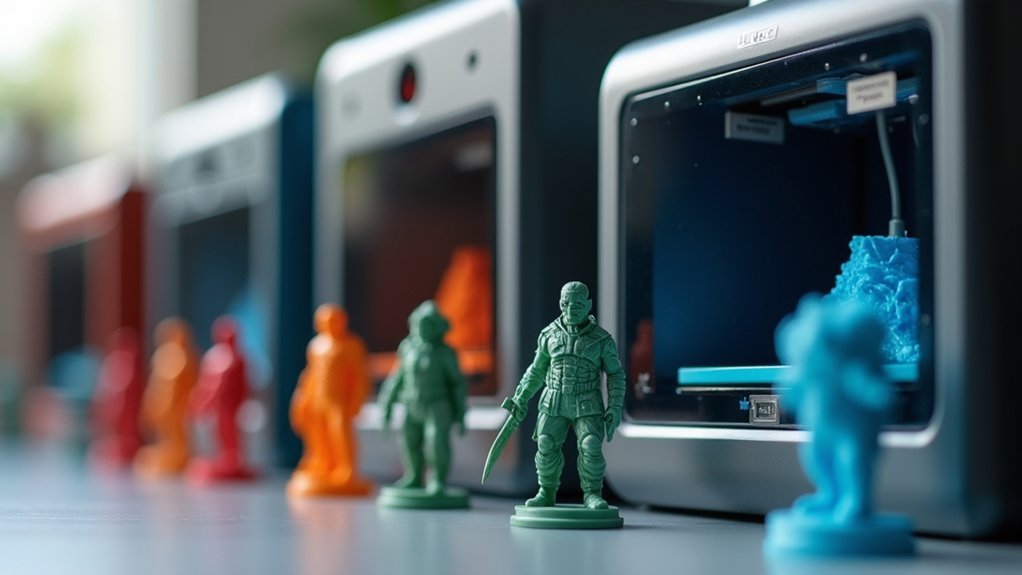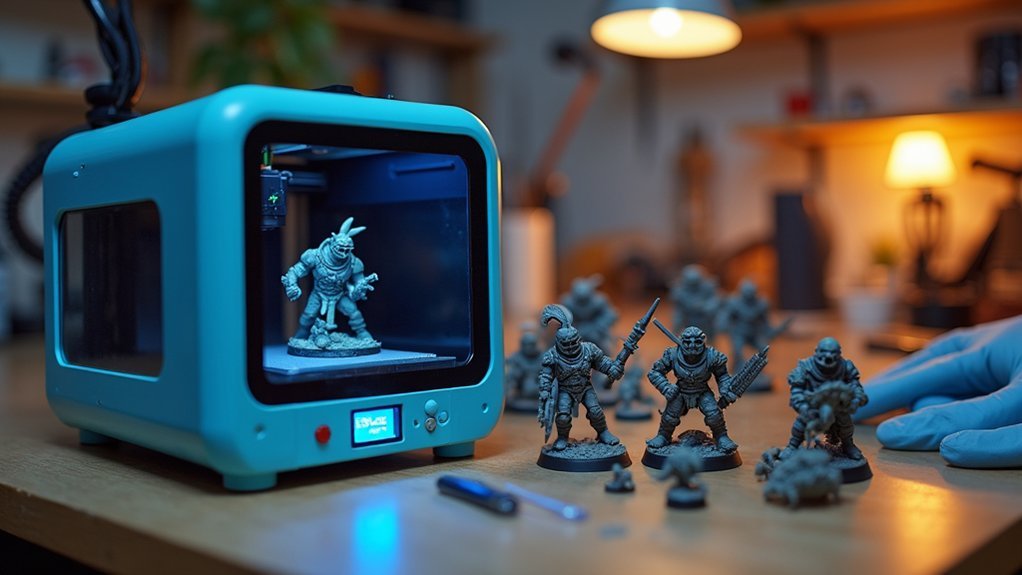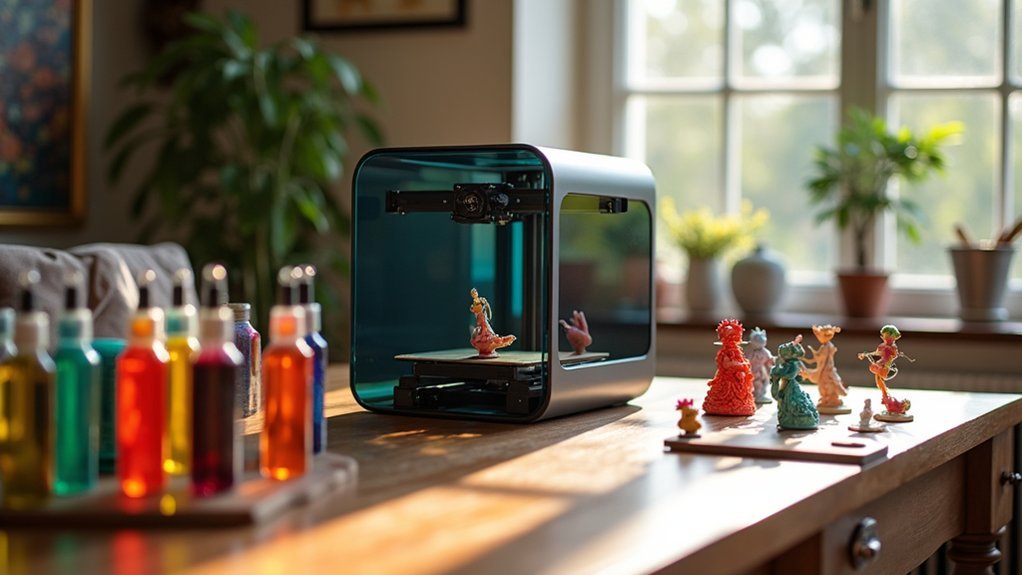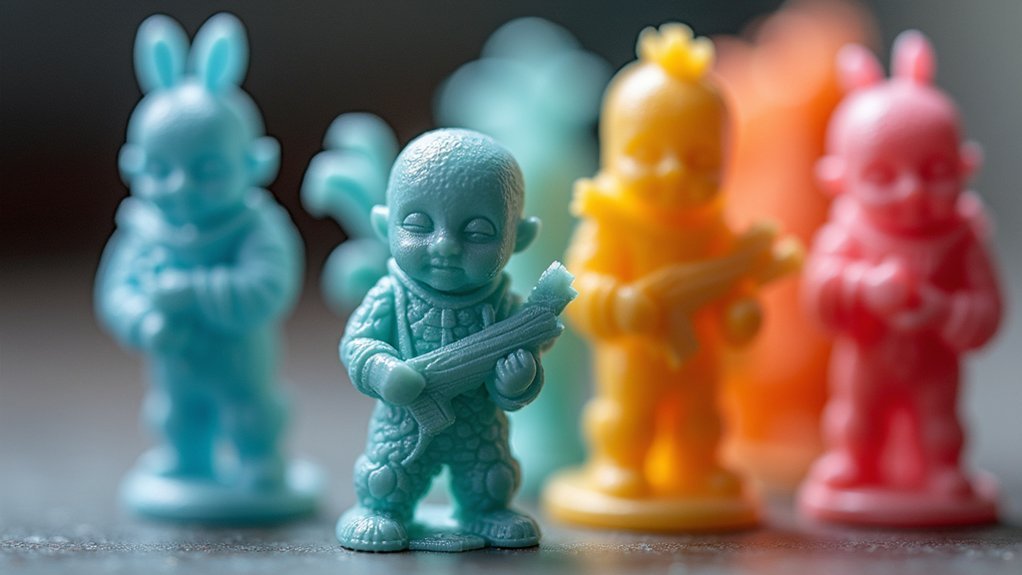You’ll want to prioritize 4K resolution printers like the Anycubic Photon Mono 2 for detailed miniatures while considering build volume—aim for at least 150mm x 80mm to print 15-20 pieces simultaneously. Don’t forget hidden costs including wash stations ($50-$150), curing equipment ($30-$100), and safety gear that can add $100+ to your budget. Choose models with strong community support for troubleshooting, verify multi-resin compatibility, and consider auto-leveling features to reduce failed prints and maximize your investment’s potential.
Print Resolution Vs Price Balance for Miniature Detail

When you’re hunting for a budget resin printer, the sweet spot between resolution and price becomes your most essential decision.
The Anycubic Photon Mono 2 delivers 4K resolution without breaking your budget, perfect for detailed miniatures.
If you need exceptional detail, the Elegoo Mars 5 Ultra offers 18-micron XY resolution, justifying its slightly higher cost.
The Phrozen Sonic Mini 8K provides outstanding 22-micron print resolution while remaining cost-effective for beginners.
Don’t overlook layer height—budget options typically support 0.01mm to 0.03mm minimum layers, vital for fine miniature details.
Consider the price-performance ratio carefully; high-resolution printers might cost more upfront but deliver superior print quality that serious hobbyists demand.
Build Volume Considerations for Batch Printing Projects
When you’re planning to print miniatures in batches, you’ll need to take into account how plate dimensions directly impact your production efficiency.
Larger build volumes like the Anycubic Photon M3 Max’s 298 x 164 x 300 mm allow you to fit approximately 45 miniatures per run, while smaller printers like the Photon M3 limit you to around 15 pieces.
Smart miniature layout on your build plate becomes essential for maximizing each print cycle and reducing overall production time.
Optimal Plate Dimensions
Although build volume might seem like a secondary consideration, it directly impacts your miniature printing efficiency and project costs.
You’ll want a budget resin printer with at least 150mm x 80mm build plate size for effective batch printing of multiple models simultaneously. A 200mm x 120mm build plate typically accommodates 20-30 small miniatures per print, greatly boosting your print efficiency.
Look for printers supporting 0.03mm to 0.05mm layer height to capture fine details without excessive print times.
The Anycubic Photon M3 Max’s 298mm x 164mm build volume exemplifies how larger prints can maximize your batch projects.
Consider models with auto-leveling build plates—they’ll simplify setup and improve consistency across your miniatures, making your budget resin printer investment more valuable for serious hobbyists.
Miniature Layout Efficiency
Three key factors determine your miniature layout efficiency: build plate dimensions, model orientation, and spacing between prints.
You’ll maximize production efficiency by choosing budget resin printers with larger dimensions like the Anycubic Photon M3 Max’s 298 x 164 x 300 mm build volume, allowing simultaneous printing of multiple miniatures.
Calculate how many models fit within your printer’s build area—the Photon Mono M5s accommodates approximately 28 miniatures per batch printing session.
Balance layer height with throughput: while 0.03mm layers deliver exceptional high detail, they’ll increase print times.
You can achieve peak output quality by selecting printers like the Elegoo Saturn 4 Ultra that combine substantial build volume with excellent print resolution, ensuring your miniatures maintain quality while maximizing batch efficiency.
Essential Features That Maximize Value for Hobbyists

Smart feature selection separates exceptional budget resin printers from disappointing purchases that’ll leave you frustrated with failed prints and poor results. Your resin printer should deliver 0.01mm minimum layer resolution for high-quality miniatures with crisp details. Auto-leveling features make setup user-friendly and prevent costly failures, especially vital for beginners.
| Feature | Budget Impact | Hobbyist Benefit |
|---|---|---|
| High resolution (0.01mm) | Low cost increase | Professional miniature quality |
| Auto-leveling | Moderate premium | Reduced failed prints |
| Multi-resin compatibility | Minimal extra cost | Project versatility |
| Print monitoring camera | Small investment | Remote supervision |
Choose budget-friendly models supporting a variety of resin types for enhanced print quality. Look for compact build volume that accommodates multiple miniatures simultaneously, maximizing efficiency while maintaining affordability and long-term part availability.
Post-Processing Equipment and Hidden Costs to Factor
You’ll need essential post-processing equipment beyond your printer, including a wash station ($50-$150) and curing station ($30-$100) to properly clean and cure your miniatures.
Don’t overlook safety gear costs, as you’ll require nitrile gloves and a respirator mask when handling toxic resin, potentially adding $50 or more to your budget.
These hidden expenses can greatly impact your total investment, so factor them into your initial purchasing decision.
Essential Wash and Cure
After you’ve successfully printed your miniatures, the real work begins with wash and cure stations that’ll transform your tacky, uncured prints into durable masterpieces.
This vital equipment streamlines post-processing by efficiently cleaning and UV curing your resin prints for best results.
Budget models range from $50 to $300, so factor this into your overall printing costs. You’ll need IPA for cleaning – buying in bulk reduces long-term expenses.
Don’t forget safety gear like protective eyewear, gloves, and masks when handling resin.
Consider your workspace setup carefully, as some budget wash and cure stations require more space than expected.
While these units add upfront costs, they’re essential for achieving the durability and finish quality that makes your miniatures truly shine.
Budget for Safety Gear
Safety gear represents a non-negotiable investment that’ll protect your health while working with toxic resin materials. You’ll need essential equipment including gloves, goggles, and a mask to prevent skin exposure and inhalation of toxic fumes during post-processing.
| Safety Item | Price Range | Purpose |
|---|---|---|
| Nitrile Gloves | $15-25 | Prevent skin contact with high-resolution resin |
| Safety Goggles | $10-20 | Protect eyes from splashes during cleaning |
| Respirator Mask | $25-50 | Filter toxic fumes and particles |
| Ventilation Fan | $30-80 | Improve air circulation in workspace |
| Apron/Coveralls | $15-35 | Protect clothing and skin |
Budget approximately $95-210 for complete safety gear. These hidden costs are essential for safe miniature printing and shouldn’t be overlooked when calculating your total investment.
Resin Compatibility and Material Cost Management

While budget resin printers offer excellent value for miniature printing, their true cost-effectiveness depends heavily on managing resin compatibility and material expenses.
You’ll want to verify your budget resin printers work with various high-resolution resins from brands like SUNLU and Anycubic to maximize print quality. Models like the Anycubic Photon Mono 2 deliver impressive 4K-6K resolution at lower material costs than premium alternatives.
Since these printers feature small build volumes, you can monitor resin consumption more easily and achieve multiple miniatures per print.
Small build volumes enable precise resin tracking and efficient batch printing of multiple miniatures per session.
Consider purchasing bulk resin and exploring generic resin brands for significant savings while maintaining acceptable quality. Look for models with auto resin refill systems to streamline your workflow and minimize waste during material cost management.
User-Friendly Software and Beginner-Friendly Setup
Getting started with budget resin printing becomes considerably easier when manufacturers prioritize user-friendly software and streamlined setup processes.
Budget resin printers like the Elegoo Mars 3 and Anycubic Photon Mono 2 include easy-to-follow setup guides that simplify assembly and calibration. User-friendly software such as Chitubox or Lychee Slicer provides intuitive interfaces with pre-configured settings perfect for newcomers.
Automatic leveling features on models like the Anycubic Photon Mono M5s eliminate complex initial setup steps, ensuring a user-friendly experience. The Elegoo Saturn 4 Ultra’s built-in camera lets you monitor print progress remotely, providing peace of mind during lengthy jobs.
These budget resin printers support various resin types and maintain compatibility with slicing software, allowing you to experiment without extensive technical knowledge.
Community Support and Upgrade Potential for Long-Term Use
One of the greatest advantages of choosing budget resin printers like the Anycubic Photon Mono 2 or Elegoo Mars series is the vibrant community support that surrounds these popular models. You’ll find extensive forums where users share troubleshooting advice and user-generated modifications to enhance your printer’s upgrade potential.
| Upgrade Type | Benefits |
|---|---|
| Build Plate Improvements | Enhanced adhesion and print quality |
| Cooling Fan Additions | Better temperature control and consistency |
| Firmware Updates | New features and improved performance |
| Resin Settings Optimization | Maximized output for specific materials |
| Custom Modifications | Tailored solutions for specific needs |
These communities help you discover the best resins and settings for long-term use, while brands like Elegoo provide regular firmware updates that keep your budget resin printers competitive and reliable.
Frequently Asked Questions
What Is the Best Cheap Resin for Miniatures?
You’ll find Elegoo’s standard resin offers the best value for miniatures. It’s affordable, reliable for beginners, and delivers quality details. Anycubic’s 4K resin is another excellent budget option.
Is a Resin Printer Better for Miniatures?
You’ll find resin printers excel for miniatures because they deliver exceptional detail with 18-micron resolution, faster printing of multiple models simultaneously, and smooth finishes that FDM printers simply can’t match for intricate designs.
Is SLA or DLP Better?
SLA’s better for intricate miniatures since you’ll get finer detail at 0.01mm resolution. However, DLP’s faster for batch printing larger quantities. Choose SLA if you prioritize exceptional detail, or DLP if you need speed and volume.
What Is the Best 3D Resin Printer for Small Parts?
You’ll want the Elegoo Mars 5 Ultra for the best small parts printing. Its 18-micron XY resolution delivers exceptional detail quality that’s perfect for intricate components and precise miniature features.





Leave a Reply